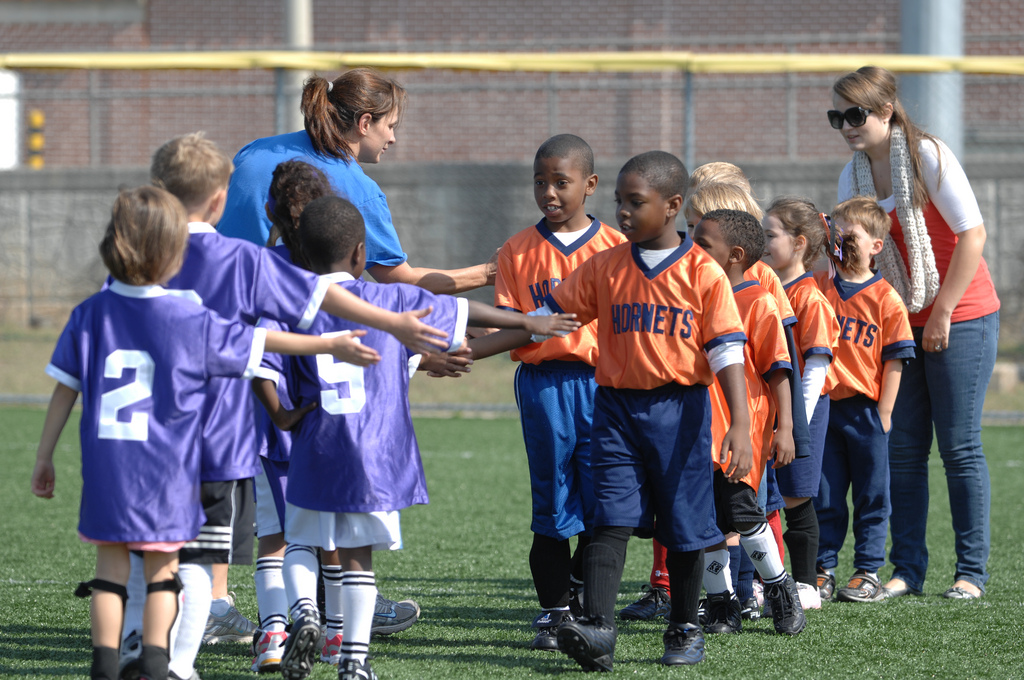Top Back-to-School Sports Injuries

September 9th, 2016
“Back-to-School” means “Back-to-Sports” for over 46 million children and teens across the US. Whether it’s Football, Soccer, Baseball, Basketball, Tennis, or Volleyball, youth sports encourage physical activity, sportsmanship, healthy competition, and teach valuable lessons about teamwork. Unfortunately, with almost any sport there can be risk of injury. In fact, nearly a third of all injuries incurred during childhood are sports-related. Some of the most common types of sports-related injuries among youth are sprains, muscle strains, repetitive motion injuries and heat-related illnesses. Below are some of the most common injuries during “Back-to-School” season and ways to prevent them from happening to your child:
- Sprained Ankles– A sprained ankle is a very common injury for young athletes. Sprains are injuries to the ligaments that connect bones to one another. An ankle sprain occurs when the ligament is stretched or torn. The signs and symptoms of an ankle sprain include pain, swelling around the joint, and the inability to walk or put weight on it. It’s impossible to prevent all ankle sprains, but by taking certain precautions, sprains will be less likely. Keeping ankles flexible and muscles strong by stretching before playing sports will help reduce the likelihood of having a sprain. It is also important to pay close attention when walking to avoid uneven turf or holes. The best treatment for a sprained ankle includes (R.I.C.E.)-Rest, ice, compression, elevation. Ibuprofen may also be given to manage the pain and reduce swelling. If your child is having difficulty walking, excessive swelling, and pain after 48 hours contact our office.
- Muscle Strains– Muscle strains are the over-stretching of a muscle which can result in muscle pain. The muscle may be sore to the touch or appear slightly bruised or swollen. This typically occurs as a result of fatigue or improper use of a muscle. Strains can happen in any muscle, but they’re most common in your lower back, neck, shoulder, and hamstring. The best prevention is proper stretching before and after exercise or sports activities. Treatment of muscle strain includes: (R.I.C.E.) Rest, Ice, Compression, Elevation. If your child is in a lot of pain, you can give him some Ibuprofen for the pain. Contact our office if your child’s muscle pain does not get better, the pain is severe and accompanied by swelling, warmth, or redness.
- Shin Splints– Shin pain occurs most frequently in young athletes involved in running, jumping, or high-impact sports. Shin splints and stress fractures are caused by repetitive stress or overuse, which happens gradually over time rather. Most commonly seen in runners, shin splints cause aching pain and tenderness after running. The best treatment for shin splints is rest. Ice, massage, and rehabilitative exercises such as lower leg stretches and heel walking can also help. An anti-inflammatory medication such as ibuprofen may be given to reduce pain. Never try to run through the pain, it will only get worse and may to progress to a stress fracture. Choose soft level surfaces for running, use properly cushioned shoes, and allow time for increasing mileage or higher levels of activity may help prevent shin splints. Running activities may be resumed once the pain has subsided.
- ACL Injuries-an ACL injury is the over-stretching or tearing of the anterior cruciate ligament (ACL). The ACL is tissue that connects the thighbone to the shinbone, at the knee. ACL injuries are common and occur especially in young athletes most often during sports like football, basketball, soccer, baseball, skiing and tennis. Symptoms may include popping, knee swelling, instability, and pain. If your child has injured their knee, they should stop all activity to prevent further injury and seek immediate medical care. Keep the area iced and elevated to prevent swelling. Treatment of the ACL depends on the type of injury and age of the patient, but most often it involves some type of surgery and physical therapy. Anti-inflammatory or pain medicine may also be prescribed to help kids deal with the pain and feel more comfortable.
Back-to-School means Back-to-Sports, so remember these simple safety tips to help prevent injuries from occurring this season:
BACK TO SPORTS SAFETY TIPS
- Make sure your child receives a physical exam before participation
- Be sure your child warms up and stretches before all practices and games
- Hydrate and drink plenty of water during and after play.
- Learn the signs and symptoms of dehydration and heat-related illnesses.
- Make sure your child has the appropriate, properly fitted, sports gear.
- Make rest a priority and take breaks during practices and games.
- Be sure to take off at least one or two days each week from any particular sport.
- Learn the signs and symptoms of a concussion.
- When in doubt, sit them out.
References:
http://www.cdc.gov/safechild/sports_injuries/index.html
http://www.niams.nih.gov/health_info/sports_injuries/child_sports_injuries.asp
http://www.education.com/reference/article/sports-participation/
http://kidshealth.org/en/parents/sports-safety.html
http://www.safekids.org/we-work-prevent-sports-injuries